Soil Arching of Piled Embankment in Equal Settlement Pattern: A Discrete Element Analysis
Abstract
:1. Introduction
2. Piled Embankment Model Test
3. DEM Modeling and Verification
3.1. DEM Modeling
3.2. Preparation Methods: Laboratory Sample and Numerical Model
- (1)
- Use the wall to layer the soil sample, generate overlapping balls in each layer according to the specified gradation and porosity. The micromechanical parameters were set as shown in Table 2, where both the interparticle friction coefficient μ and the acceleration of gravity were set to zero to obtain a dense state.
- (2)
- Cycle enough steps to make the balls collide and squeeze in each layer to make the particles evenly distributed.
- (3)
- Delete the wall between each layer and cycle enough steps to gain a new equilibrium.
- (4)
- Replace the ball with a clump in the original position. Follow the principle of equivalent area and mass when replacing. At the same time, the clump is randomly rotated by an angle around the center point to ensure that the particle arrangement is random. Subsequently, the model is cycled through enough steps to reach equilibrium.
- (5)
- The gravity is restored to the normal level. The frictional coefficient μ is reset to the values in Table 2. The model cycles until reaching the final equilibrium state.
3.3. Validation of DEM Modeling
3.4. Analysis of the Equal Settlement Pattern
3.4.1. Vertical Stress
3.4.2. Equal Settlement
4. Influence of Pile Cap Width and Embankment Height on the Formation of the Equal Settlement Pattern
4.1. DEM Simulation Conditions
4.2. Vertical Displacement
4.3. Shear Plane
4.4. Formation Mechanism of the Equal Settlement Pattern
5. Conclusions
Author Contributions
Funding
Institutional Review Board Statement
Informed Consent Statement
Data Availability Statement
Conflicts of Interest
References
- Briançon, L.; Simon, B. Performance of pile-supported embankment over soft soil: Full-scale experiment. J. Geotech. Geoenviron. Eng. 2012, 138, 551–561. [Google Scholar] [CrossRef]
- Liu, H.L.; Kong, G.Q.; Chu, J.; Ding, X.M. Grouted gravel column supported highway embankment over soft clay: Case study. Can. Geotech. J. 2015, 52, 1725–1733. [Google Scholar] [CrossRef]
- Cao, W.Z.; Zheng, J.J.; Zhang, J.; Zhang, R.J. Field test of a geogrid-reinforced and floating pile-supported embankment. Geosynth. Inter. 2016, 23, 348–361. [Google Scholar] [CrossRef]
- Pan, Y.T.; Liu, Y.; Xiao, H.W.; Lee, F.H.; Phoon, K.K. Effect of spatial variability on short- and long-term behaviour of axially-loaded cement-admixed marine clay column. Comput. Geotech. 2018, 94, 150–168. [Google Scholar] [CrossRef]
- Al-Naddaf, M.; Han, J.; Xu, C.; Jawad, S.; Abdulrasool, G. Experimental investigation of soil arching mobilization and degradation under localized surface loading. J. Geotech. Geoenviron. Eng. 2019, 145, 04019114. [Google Scholar] [CrossRef]
- Chalak, C.; Briancon, L.; Villard, P. Coupled numerical and experimental analyses of load transfer mechanismsin granular-reinforced platform overlying cavities. Geotext. Geomembr. 2019, 19, 587–597. [Google Scholar] [CrossRef]
- da Silva Burke, T.S.; Elshafie, M.Z.E.B. Geosynthetic-reinforced soils above voids: Observation of soil and geosynthetic deformation mechanisms. Geotext. Geomembr. 2021, 49, 1–18. [Google Scholar] [CrossRef]
- Ghosh, B.; Fatahi, B.; Khabbaz, H.; Nguyen, H.H.; Kelly, R. Field study and numerical modelling for a road embankment built on soft soil improved with concrete injected columns and geosynthetics reinforced platform. Geotext. Geomembr. 2021, 49, 804–824. [Google Scholar] [CrossRef]
- Lee, T.; Lee, S.H.; Lee, I.W.; Jung, Y.H. Lessons from Full-Scale Experiments on Piled Embankments with Different Geosynthetic Reinforcements. KSCE J. Civ. Eng. 2021, 25, 442–450. [Google Scholar] [CrossRef]
- Terzaghi, K. Theoretical Soil Mechanics; Wiley: New York, NY, USA, 1943. [Google Scholar]
- Hewlett, W.J.; Randolph, M.F. Analysis of piled embankment. Ground Eng. 1988, 21, 12–18. [Google Scholar]
- Zhuang, Y.; Wang, K.Y. Finite-element analysis of arching in highway piled embankments subjected to moving vehicle loads. Geotechnique 2018, 68, 857–868. [Google Scholar] [CrossRef]
- Tran, Q.A.; Villard, P.; Dias, D. Discrete and continuum numerical modeling of soil arching between piles. Int. J. Geomech. 2019, 19, 04018195. [Google Scholar] [CrossRef] [Green Version]
- Alonso, J.; Moya, M.; Asensio, L.; de la Morena, G.; Galve, J.P.; Navarro, V. A catenary model for the analysis of arching effect in soils and its application to predicting sinkhole collapse. Géotechnique 2020, 1–46. [Google Scholar] [CrossRef]
- Lai, H.J.; Zheng, J.J.; Cui, M.J.; Chu, J. “Soil arching” for piled embankments: Insights from stress redistribution behaviour of DEM modelling. Acta Geotech. 2020, 15, 2117–2136. [Google Scholar] [CrossRef]
- Rui, R.; Han, J.; Zhang, L.; Zhai, Y.; Cheng, Z.; Chen, C. Simplified method for estimating vertical stress-settlement responses of piled embankments on soft soils. Comput. Geotech. 2020, 119, 103365. [Google Scholar] [CrossRef]
- Pham, T.A.; Dias, D. Comparison and evaluation of analytical models for the design of geosyntheticreinforced and pile-supported embankments. Geotext. Geomembr. 2021, 49, 528–549. [Google Scholar] [CrossRef]
- Kempfert, H.G.; Stadel, M.; Zaeske, D. Berechnung von geokunstst off between trags chichten über pfahlelementen. Bautechnik 1997, 74, 818–825. (In German) [Google Scholar]
- Zaeske, D.; Kempfert, H.G. Calculation and Behaviour of Unreinforced and Reinforced Bearing Layers over Point- or Line-Shaped Bearing Elements. Bauingenieur 2002, 77, 80–86. (In German) [Google Scholar]
- van Eekelen, S.J.M.; Bezuijen, A.; van Tol, A.F. An analytical model for arching in piledembankments. Geotext. Geomembr. 2013, 39, 78–102. [Google Scholar] [CrossRef]
- van Eekelen, S.J.M.; Bezuijen, A.; van Tol, A.F. Validation ofanalytical models for the design of basal reinforced piled embankments. Geotext. Geomembr. 2015, 43, 56–81. [Google Scholar] [CrossRef] [Green Version]
- Iglesia, G.R.; EinsteinI, H.H.; Whitman, R.V. Investigation of soil arching with centrifuge tests. J. Geotech. Geoenviron. Eng. 2014, 140, 04013005. [Google Scholar] [CrossRef]
- Rui, R.; van Tol, A.F.; Xia, X.L.; van Eekelen, S.J.M.; Hu, G.; Xia, Y.Y. Evolution of soil arching; 2D DEM simulations. Comput. Geotech. 2016, 73, 199–209. [Google Scholar] [CrossRef]
- Rui, R.; van Tol, A.F.; Xia, Y.Y.; van Eekelen, S.J.M.; Hu, G. Investigation of soil-arching development in dense sand by 2D model tests. Geotech. Test. J. 2016, 39, 415–430. [Google Scholar] [CrossRef] [Green Version]
- Chevalier, B.; Combe, G.; Villard, P. Experimental and discrete element modeling studies of the trapdoor problem: Influence of the macro-mechanical frictional parameters. Acta Geotech. 2012, 7, 15–39. [Google Scholar] [CrossRef]
- Eskisar, T.; Otani, J.; Hironaka, J. Visualization of soil arching on reinforced embankment with rigid pile foundation using X-ray CT. Geotext. Geomembr. 2012, 32, 44–54. [Google Scholar] [CrossRef]
- Xu, C.J.; Liang, L.J.; Chen, Q.Z.; Chen, Y.F. Experimental study of soil arching effect under seepage condition. Acta Geotech. 2019, 14, 2031–2044. [Google Scholar] [CrossRef]
- Jenck, O.; Dias, D.; Kastner, R. Soft ground improvement by vertical rigid piles twodimensional physical modelling and comparison with current design methods. Soils Found. 2005, 45, 15–30. [Google Scholar] [CrossRef] [Green Version]
- Chen, Y.M.; Cao, W.P.; Chen, R.P. An experimental investigation of soil arching within basal reinforced and unreinforced piled embankments. Geotext. Geomembr. 2008, 26, 164–174. [Google Scholar]
- Lai, H.J.; Zheng, J.J.; Zhang, R.J.; Cui, M.J. Visualization of the formation and features of soil arching within a piled embankment by discrete element method simulation. J. Zhejiang Univ.-Sci. A 2016, 17, 803–817. [Google Scholar] [CrossRef] [Green Version]
- BSI (British Standards Institution). Code of Practice for Strengthened/Reinforced Soils and Other Fills; BSI: London, UK, 2010; BSI: BS8006-1. [Google Scholar]
- Zhuang, Y.; Ellis, E.; Yu, H.S. Three-dimensional finite-element analysis of arching in a piled embankment. Géotechnique 2012, 62, 1127–1131. [Google Scholar] [CrossRef]
- Jenck, O.; Dias, D.; Kastner, R. Discrete element modelling of a granular platform supported by piles in soft soil-validation on a small scale model test and comparison to a numerical analysis in a continuum. Comput. Geotech. 2009, 36, 917–927. [Google Scholar] [CrossRef]
- Han, J.; Bhandari, A.; Wang, F. DEM analysis of stresses and deformations of geogrid-reinforced embankments over piles. Int. J. Geomech. 2012, 12, 340–350. [Google Scholar] [CrossRef]
- Chen, R.P.; Liu, Q.W.; Wu, H.N.; Wang, H.L.; Meng, F.Y. Effect of particle shape on the development of 2D soil arching. Comput. Geotech. 2020, 125, 103662. [Google Scholar] [CrossRef]
- He, G.F.; Li, Z.G.; Yuan, Y.; Li, X.H.; Hu, L.H.; Zhang, Y. Optimization analysis of the factors affecting the soil arching effect between landslide stabilizing piles. Nat. Resour. Model. 2018, 31, e12148. [Google Scholar] [CrossRef]
- Itasca. Particle Flow Code in Two Dimensions, Version 5.0; Itasca Consulting Group Inc.: Tokyo, Japan, 2016. [Google Scholar]
- Cundall, P.A.; Strack, O.D.L. A discrete numerical model for granular assemblies. Geotechnique 1979, 29, 47–65. [Google Scholar] [CrossRef]
- Badakhshan, E.; Noorzad, A.; Bouazza, A.; Zameni, S.; King, L. A 3D-DEM investigation of the mechanism of arching within geosynthetic-reinforced piled embankment. Int. J. Solids Struct. 2020, 187, 58–74. [Google Scholar] [CrossRef]
- Jiang, M.J.; Konrad, J.M.; Leroueil, S. An efficient technique for generating homogeneous specimens for DEM studies. Comput. Geotech. 2003, 30, 579–597. [Google Scholar] [CrossRef]
- Han, J.; Gabr, M.A. Numerical analysis of geosynthetic-reinforced and pile-supported earth platforms over soft soil. J. Geotech. Geoenviron. Eng. 2002, 128, 44–53. [Google Scholar] [CrossRef]
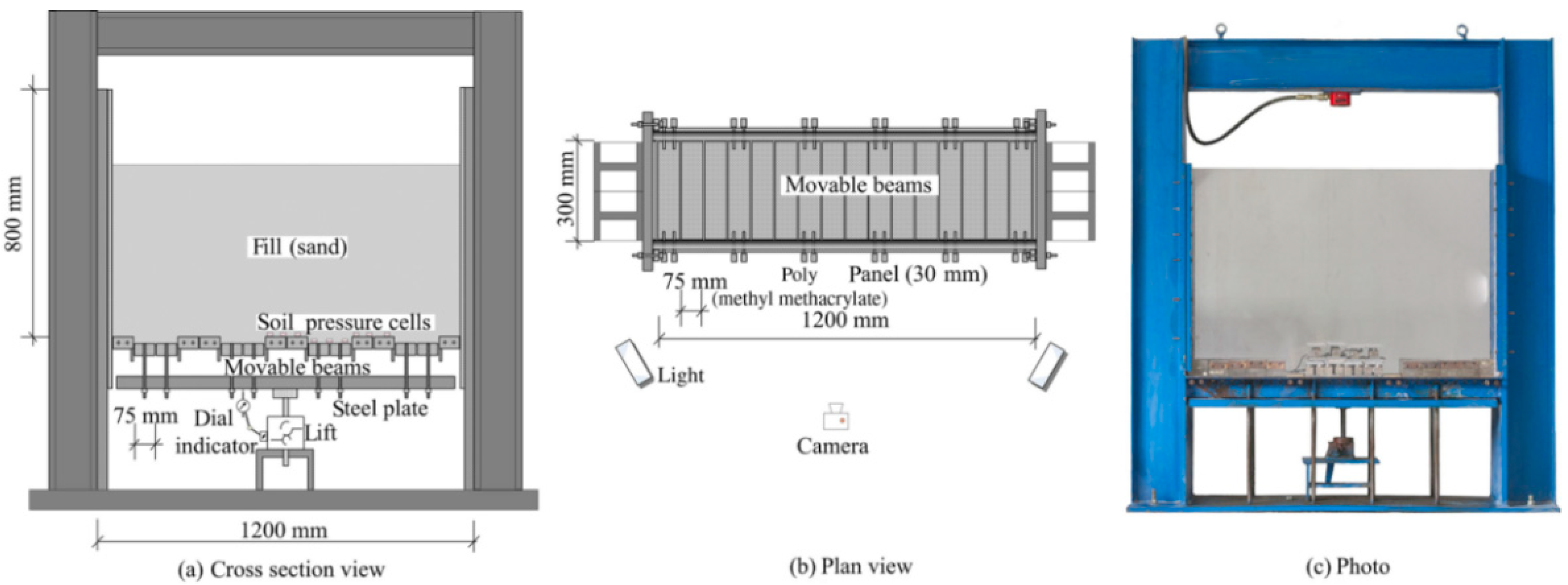


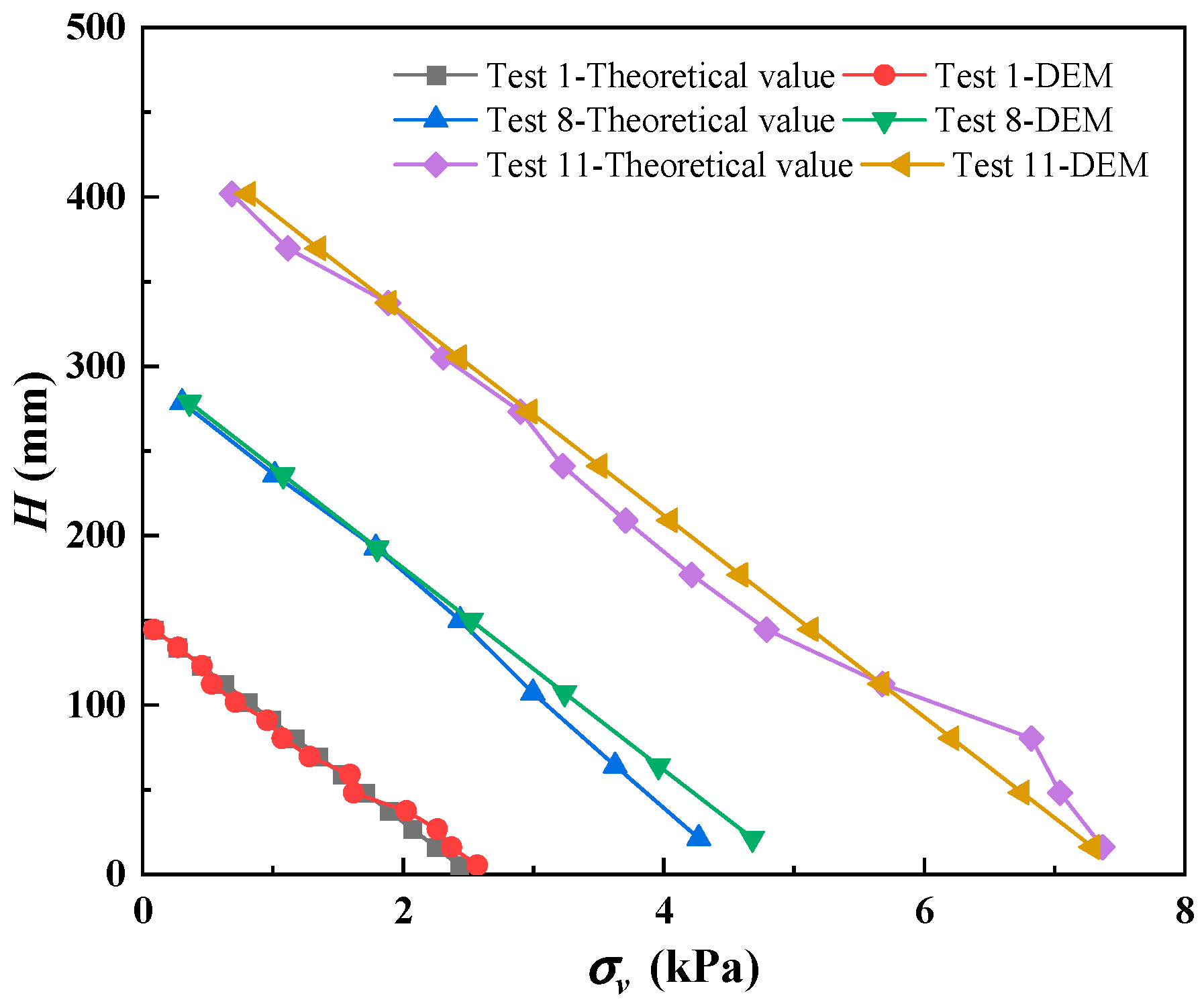

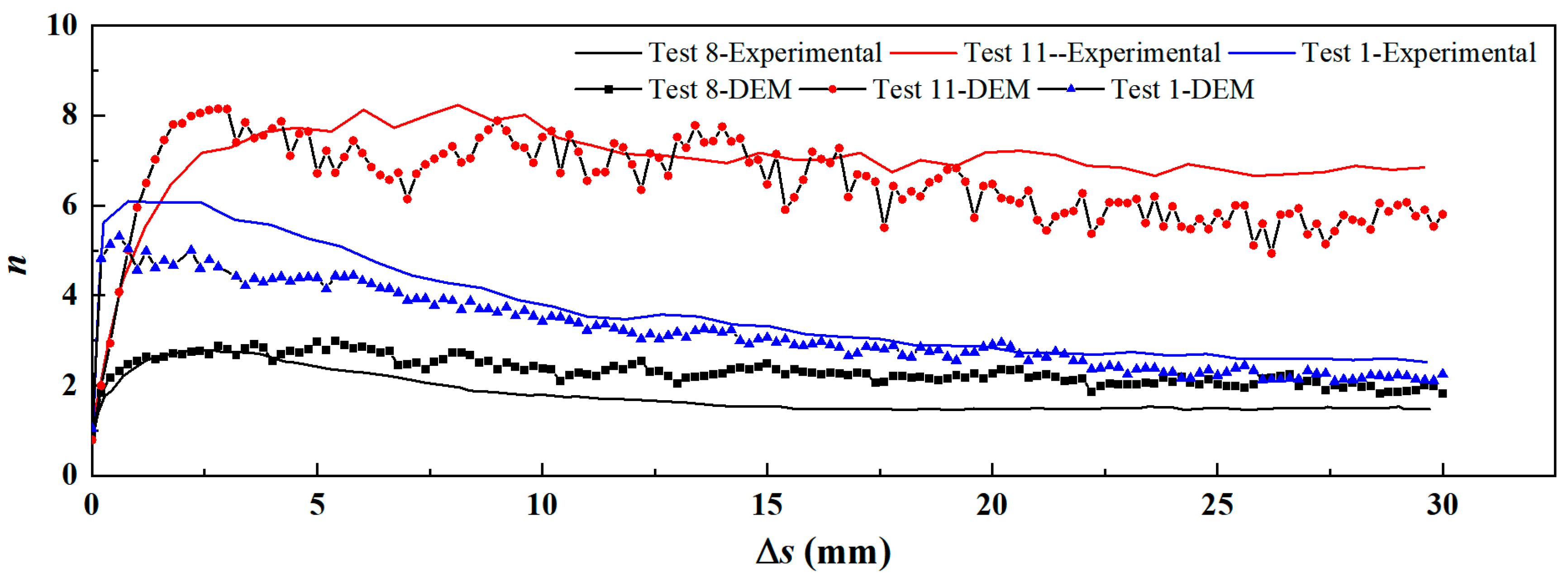
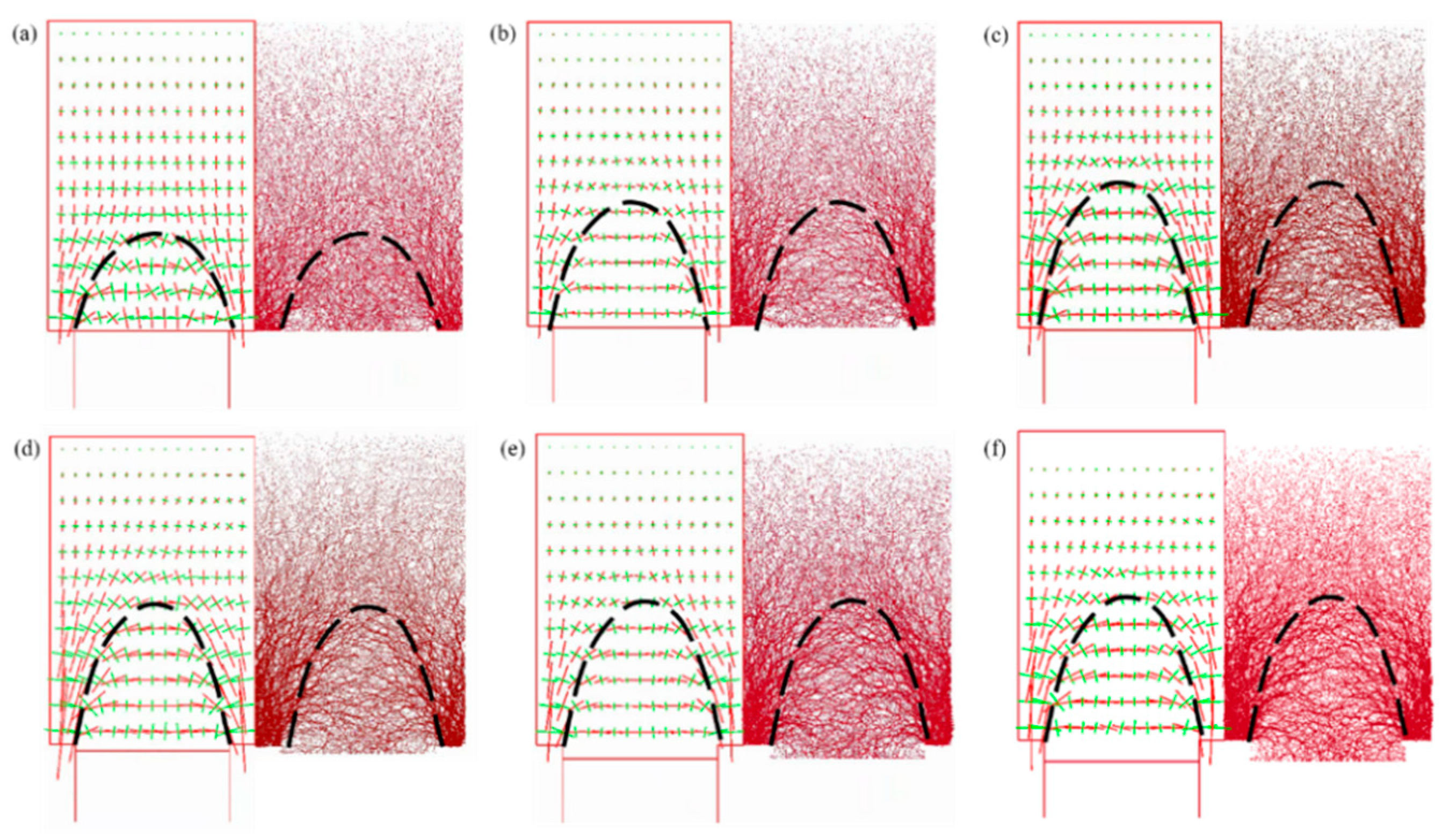
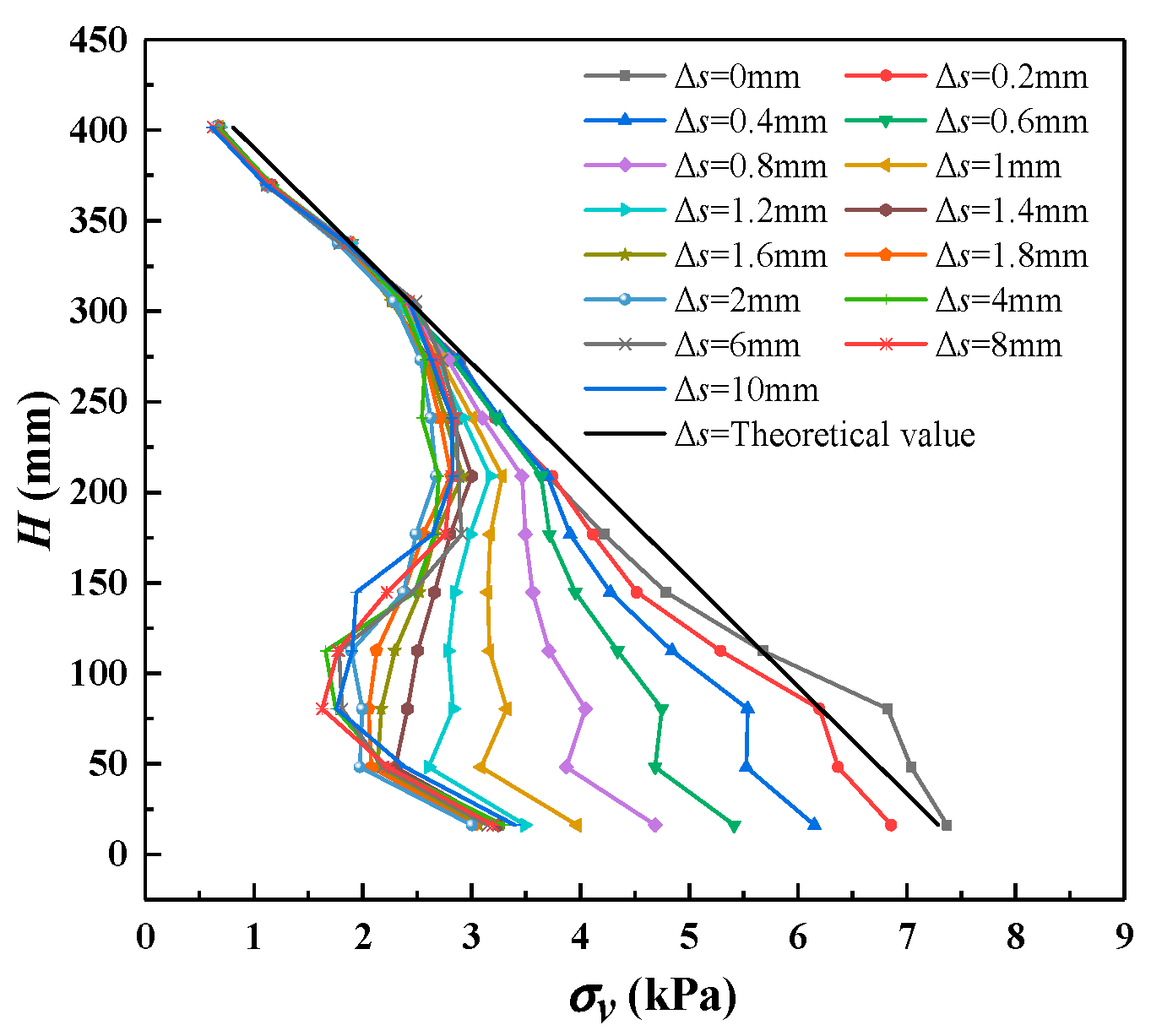
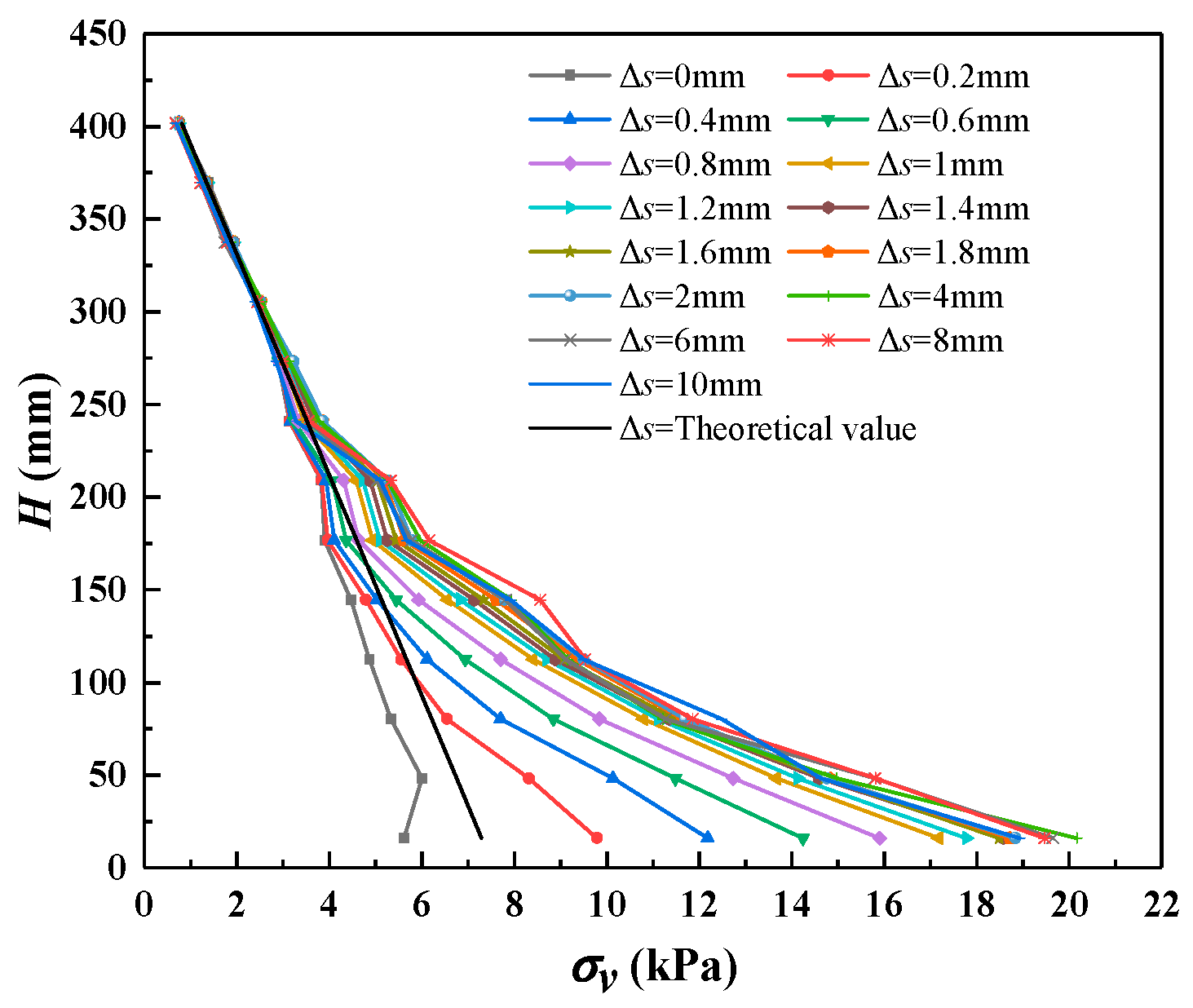
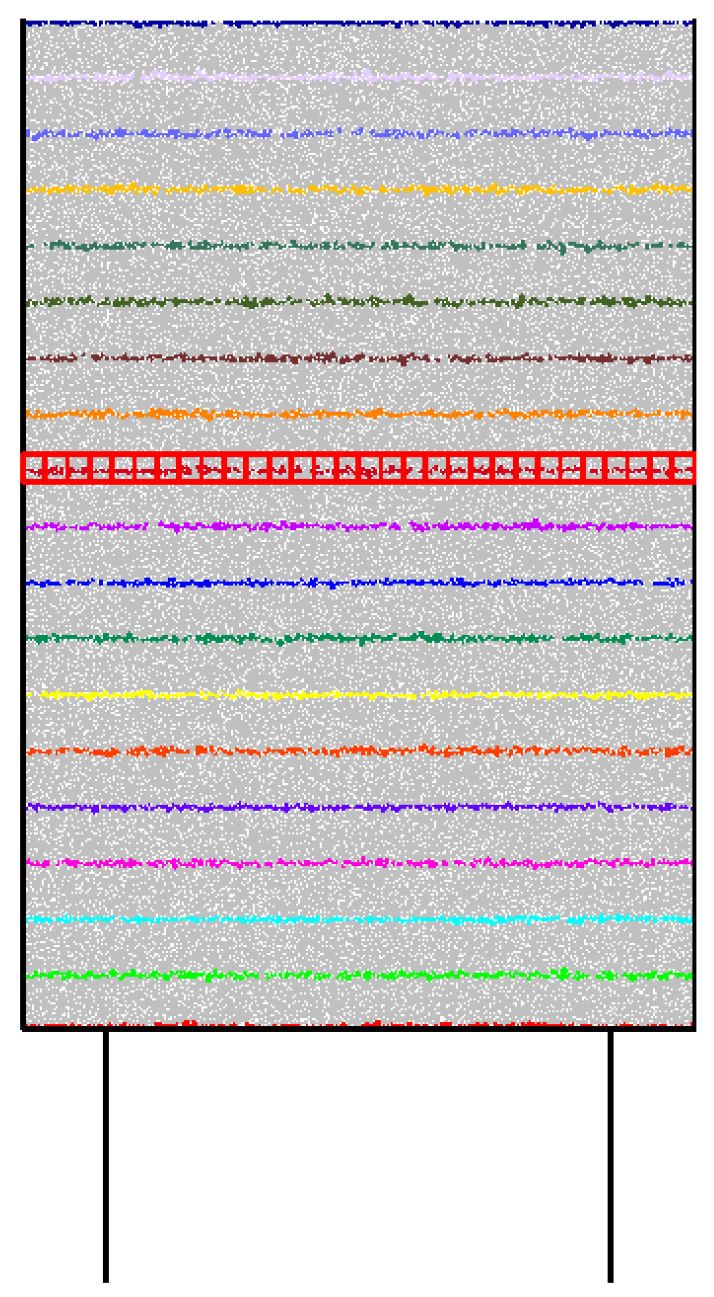


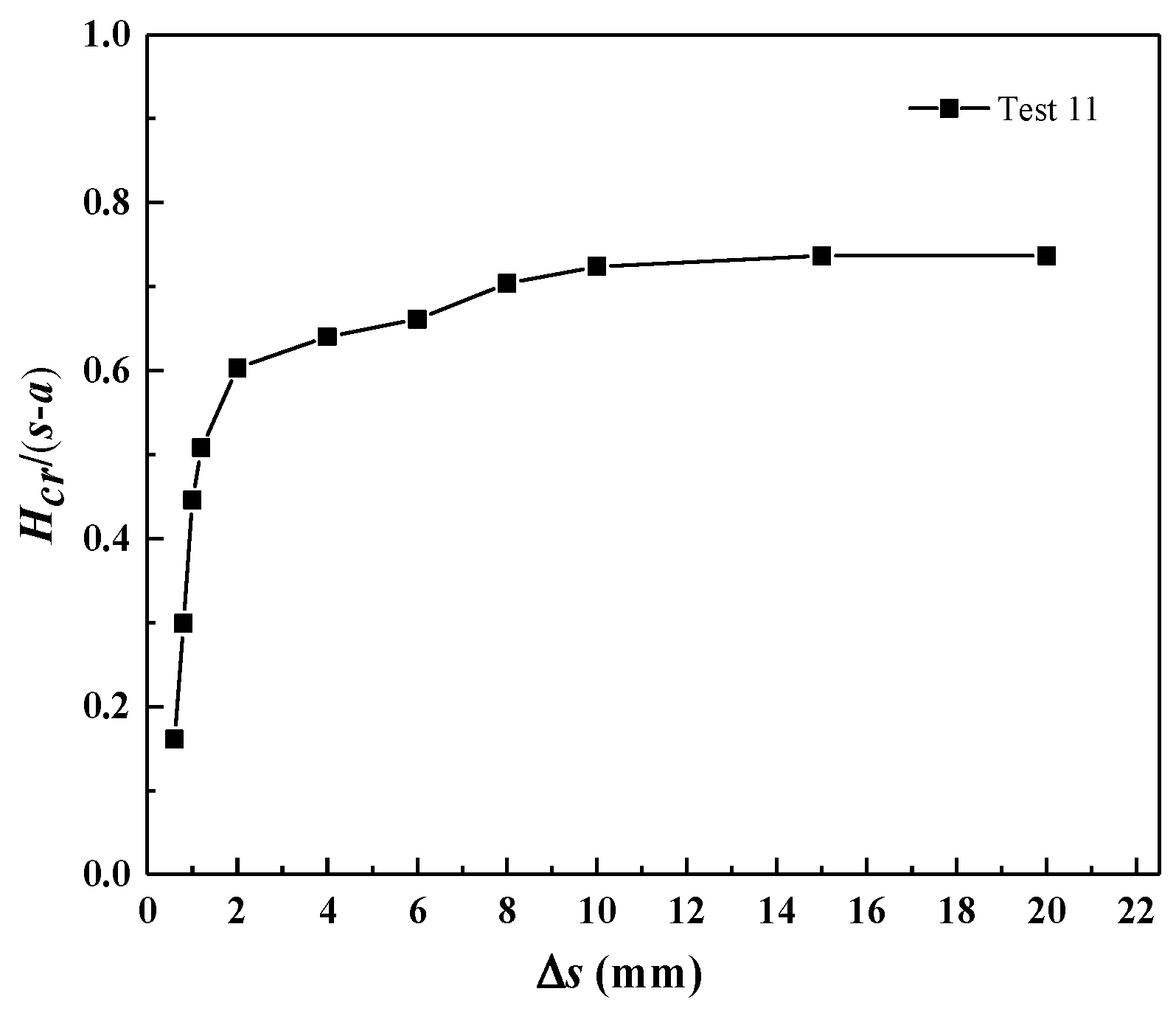
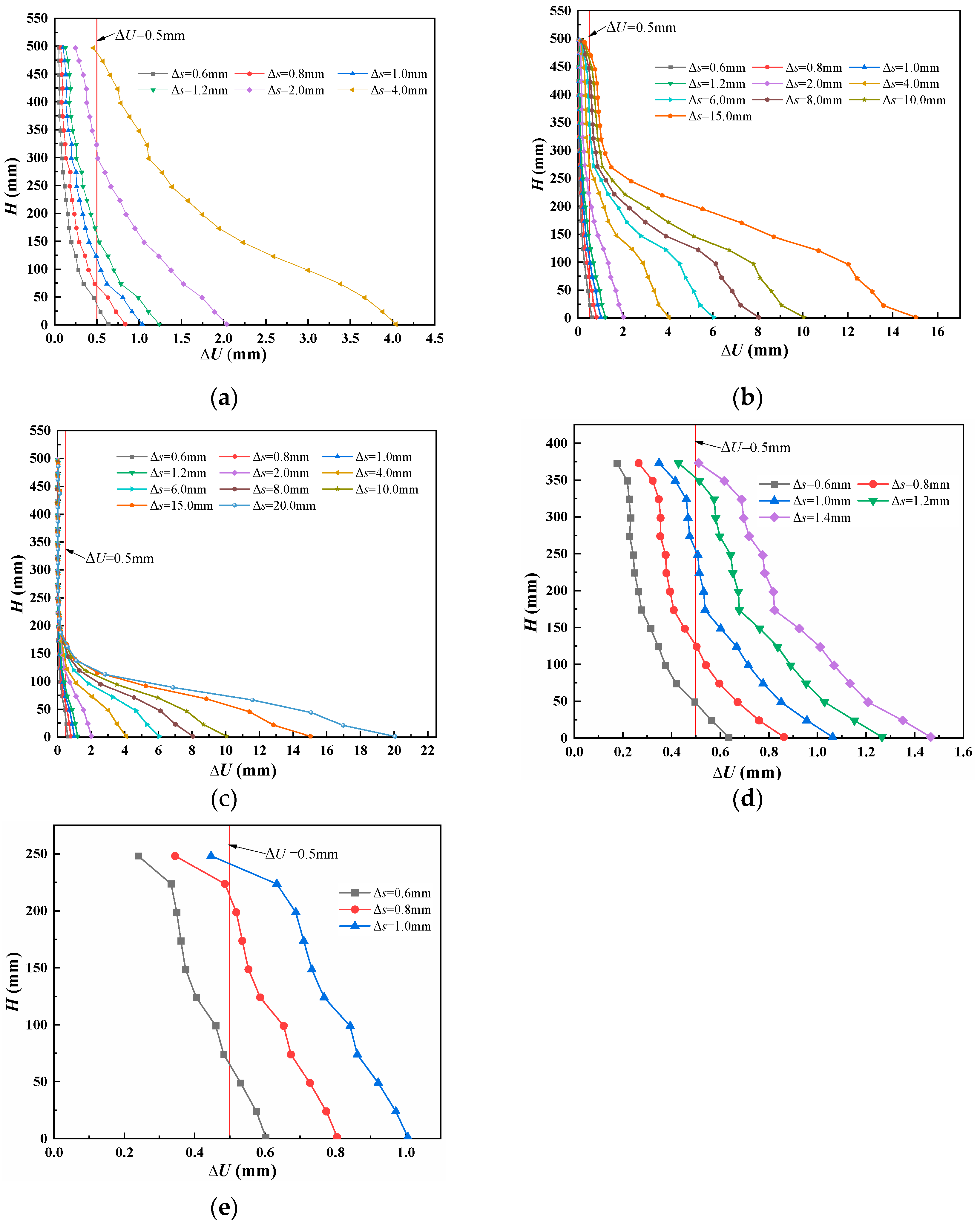
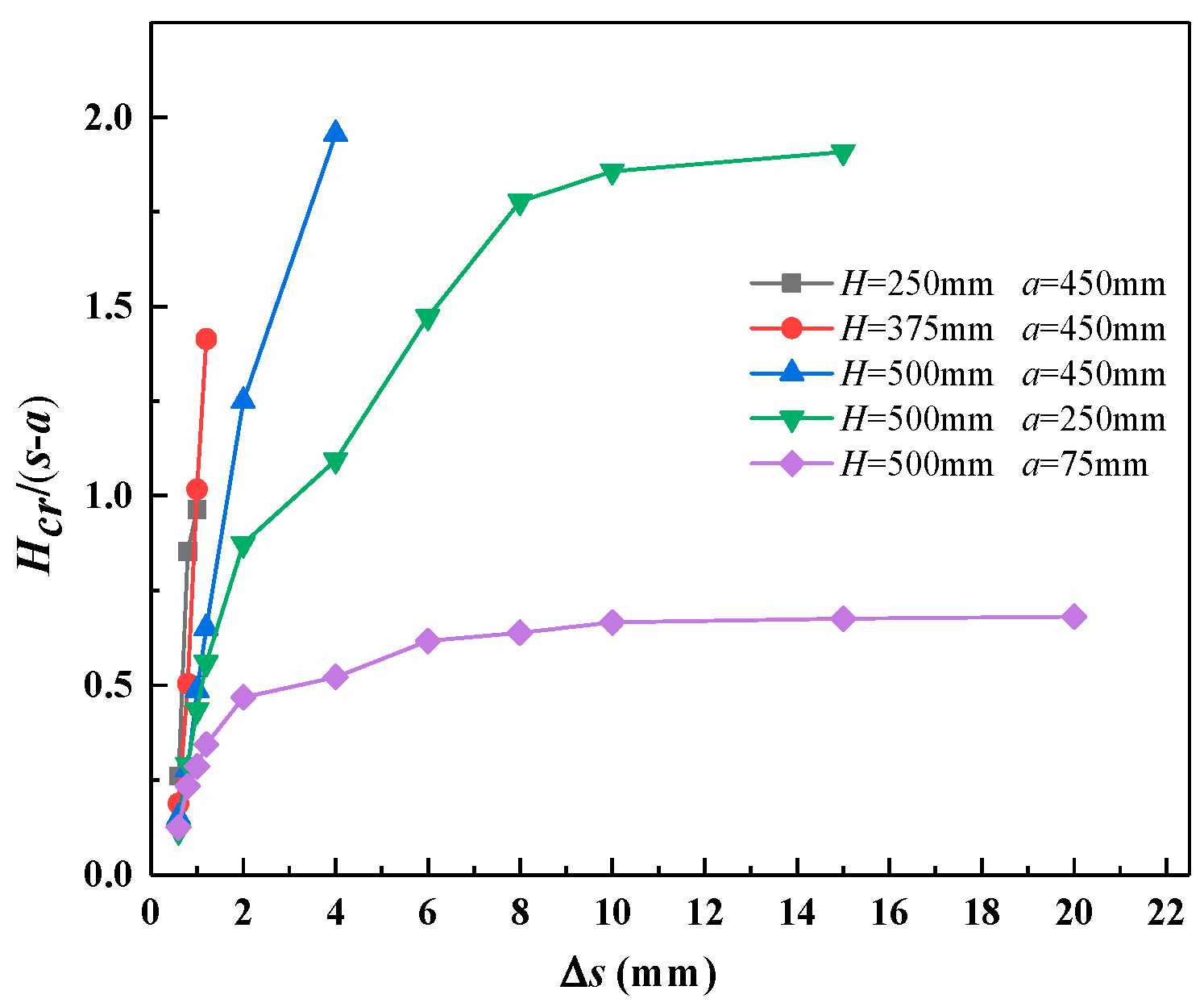

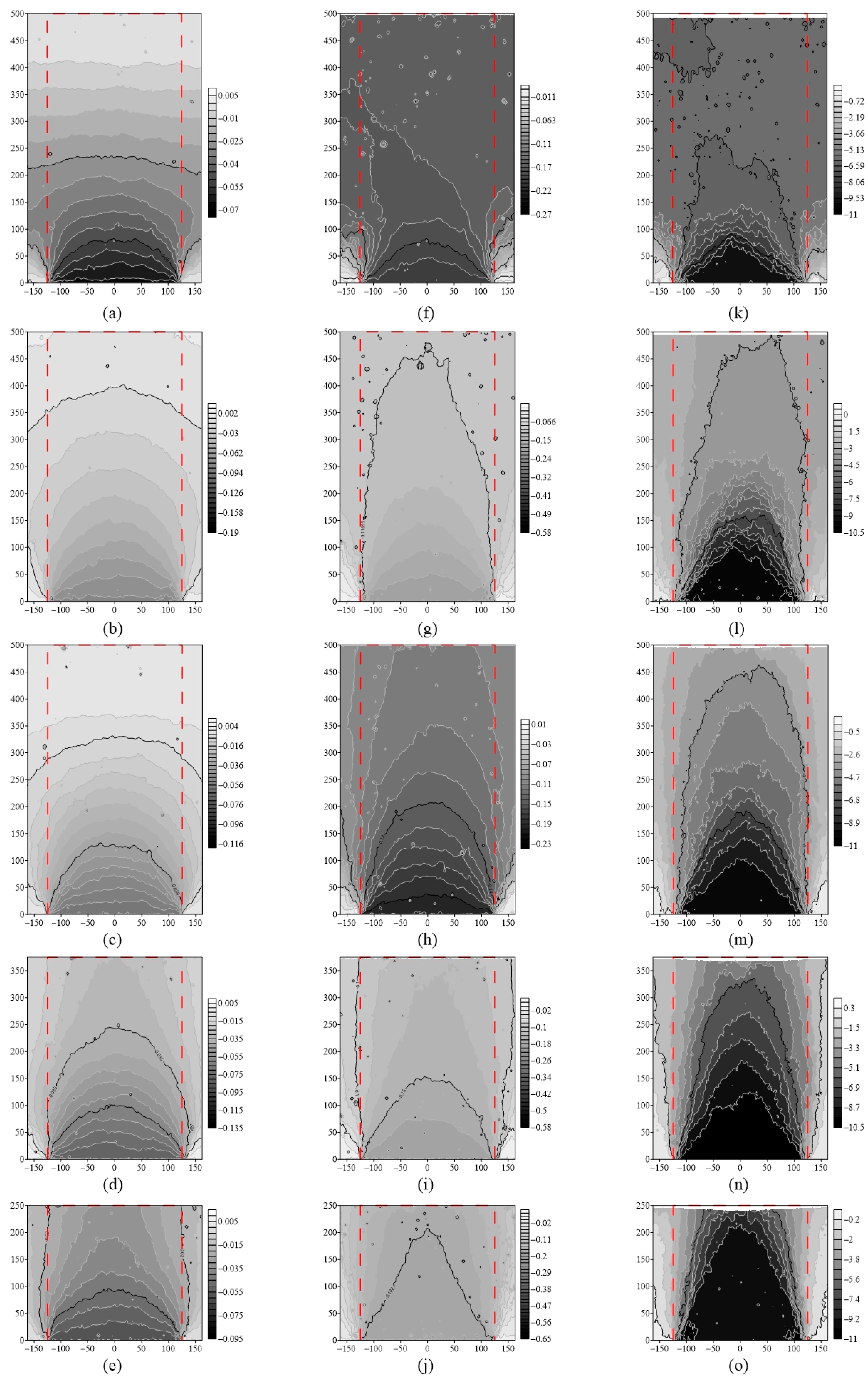
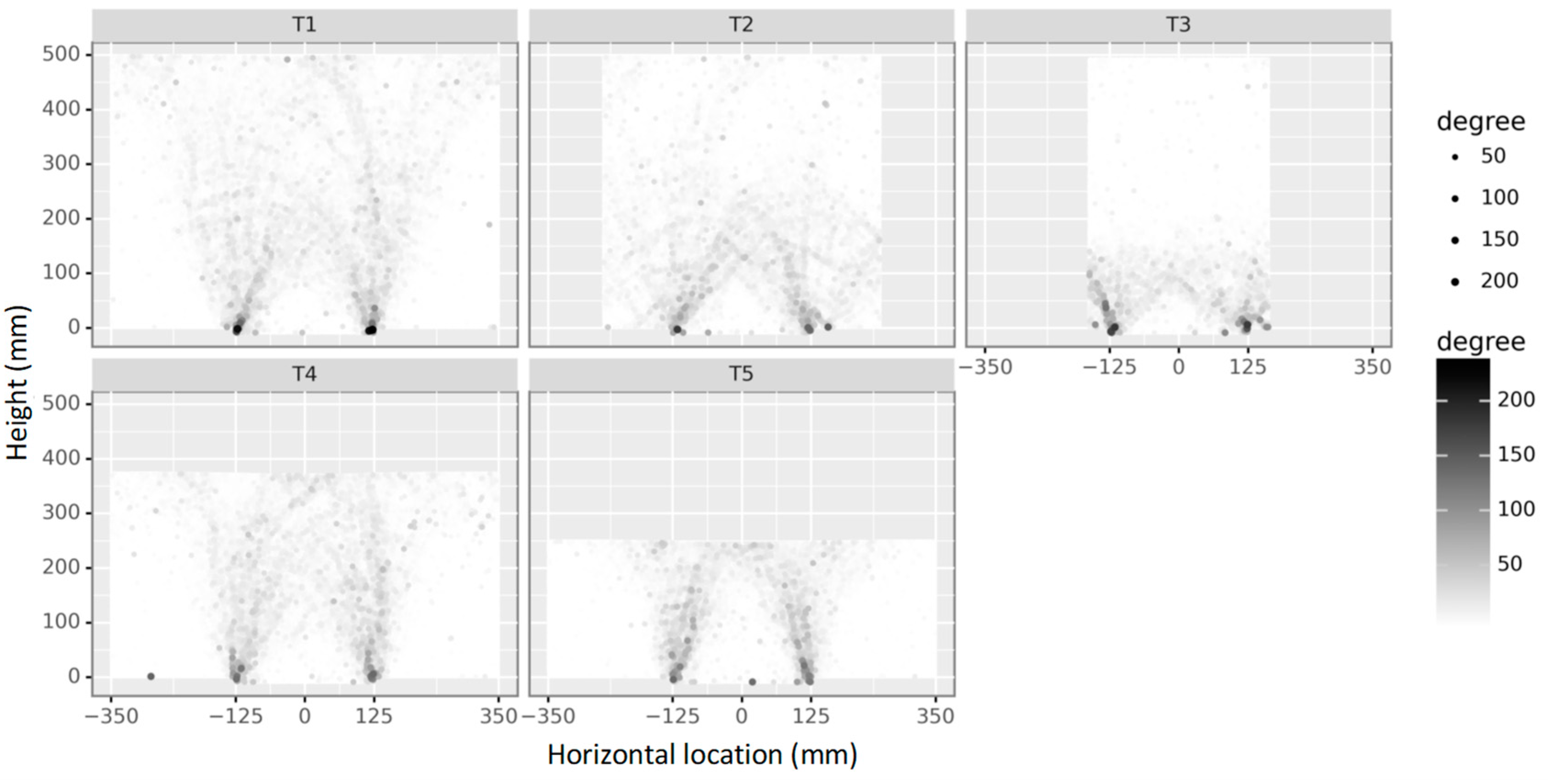

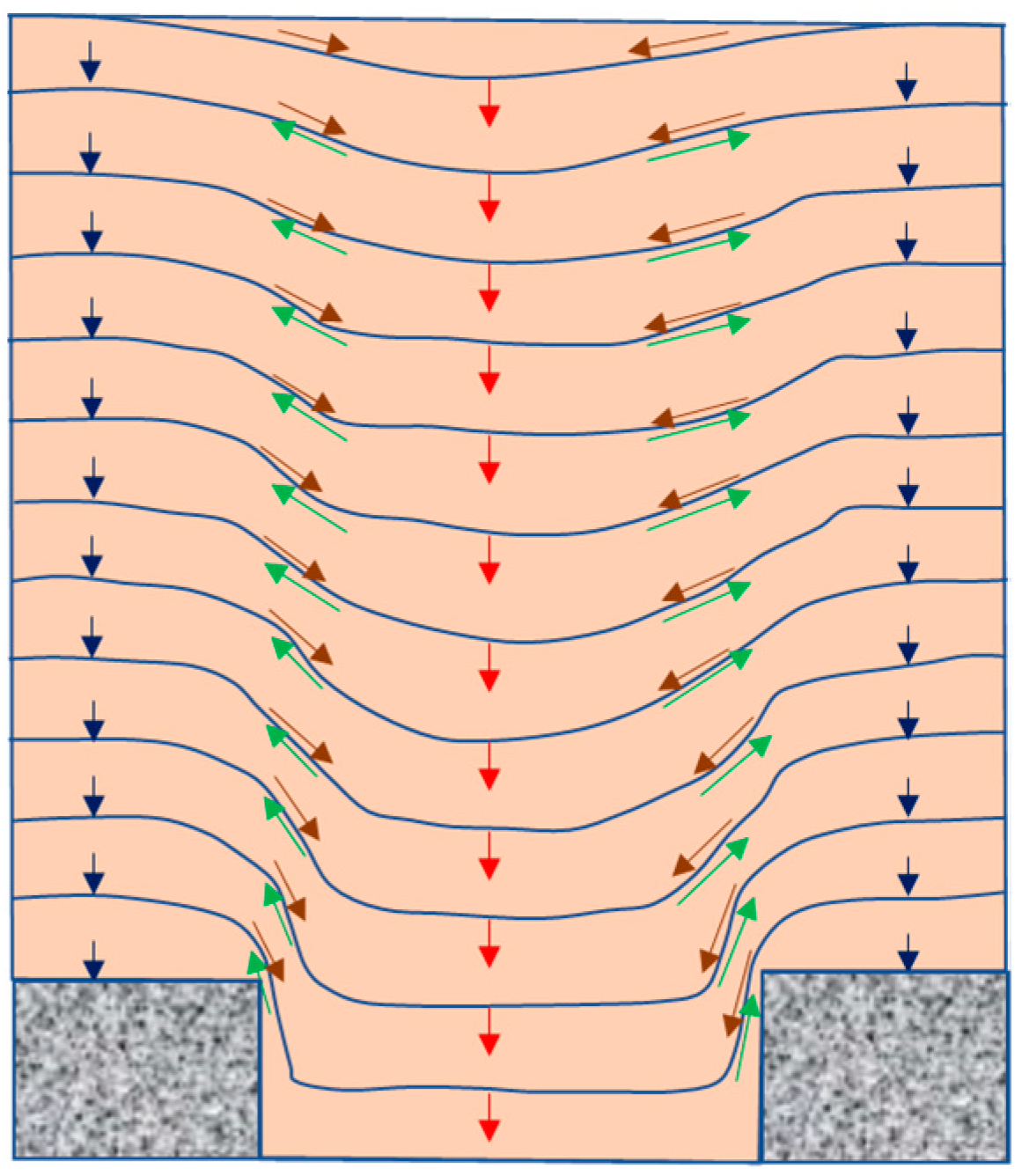
| Test | Height H (mm) | Trapdoor Width (s-a) (mm) | Pile Width a (mm) | Diameter of Sand d (mm) |
|---|---|---|---|---|
| Test 1 | 150 | 75 | 75 | 0.25–0.425 |
| Test 8 | 300 | 300 | 225 | 0.425–1.0 |
| Test 11 | 450 | 225 | 75 | 0.425–1.0 |
| Parameters | Values |
|---|---|
| Pebble–pebble | |
| Normal stiffness of clump kn | 5.0 × 106 N/m |
| Shear stiffness of clump ks | 5.0 × 106 N/m |
| Friction coefficient of clump μ | 0.6 |
| Density of clump ρ | 2000 kg/m3 |
| Local damping ratio | 0.7 |
| Pebble–facet | |
| Normal stiffness of wall kn | 8.0 × 107 N/m |
| Shear stiffness of wall ks | 8.0 × 107 N/m |
| Friction coefficient of wall μ | 0 |
| Porosity of assembly | 0.16 |
| Case | Height H (mm) | Trapdoor Width (s-a) (mm) | Pile Width a (mm) | H/(s-a) | (s-a)/a | Diameter of Sand d (mm) | Expected Displacement Pattern |
|---|---|---|---|---|---|---|---|
| T1 | 500 | 250 | 450 | 2 | 0.56 | 0.25–0.425 | TSE |
| T2 | 500 | 250 | 250 | 2 | 1 | 0.25–0.425 | TSE |
| T3 | 500 | 250 | 75 | 2 | 3.3 | 0.25–0.425 | ES |
| T4 | 375 | 250 | 450 | 1.5 | 0.56 | 0.25–0.425 | TSE |
| T5 | 250 | 250 | 450 | 1 | 0.56 | 0.25–0.425 | TE |
Publisher’s Note: MDPI stays neutral with regard to jurisdictional claims in published maps and institutional affiliations. |
© 2021 by the authors. Licensee MDPI, Basel, Switzerland. This article is an open access article distributed under the terms and conditions of the Creative Commons Attribution (CC BY) license (https://creativecommons.org/licenses/by/4.0/).
Share and Cite
Wang, K.; Cao, J.; Wang, X.; Ning, Y. Soil Arching of Piled Embankment in Equal Settlement Pattern: A Discrete Element Analysis. Symmetry 2021, 13, 1627. https://doi.org/10.3390/sym13091627
Wang K, Cao J, Wang X, Ning Y. Soil Arching of Piled Embankment in Equal Settlement Pattern: A Discrete Element Analysis. Symmetry. 2021; 13(9):1627. https://doi.org/10.3390/sym13091627
Chicago/Turabian StyleWang, Kangyu, Jun Cao, Xinquan Wang, and Yingjie Ning. 2021. "Soil Arching of Piled Embankment in Equal Settlement Pattern: A Discrete Element Analysis" Symmetry 13, no. 9: 1627. https://doi.org/10.3390/sym13091627







